




Whether you live in a cluster of creativity, or you’re a venue looking to attract more visitors, an artist trail or open studio can turn a group of individuals into a community.
Usually taking place once a year, they can quickly become a highlight in a town’s calendar, bringing members of the public and artists together in an organised but informal setting.
No two trails are the same, but there are some commonalities that most adhere to: artists open their homes or studios to allow people to view their work, discuss the creative process and buy something; each venue is allocated its own unique number printed on bright, clear signage displayed around the trail; and visitors are given a map with venue numbers, locations and descriptions of the work to help them find their way. Most events last two days, usually over a weekend – but everything else depends on who lives or works in your area and what they do.
“The beauty of a trail is you could go to an artist’s studio and see something really polished, and then the next place you visit is the home of somebody who has just started creating things,” says Fiona Clabon who runs South Bristol Arts Trail. “I think it’s nice to have a mix and it means people never know what they’re going to come across next.”

Apart from the obvious mix of paintings, drawings, photography, textiles and craftwork you’d expect to find on a trail, it’s worth exploring what other talents lie in your community. At Kirkcudbright Art and Crafts Trail in Dumfries & Galloway, organiser Colin Saul invites local musicians to play around the town, in people’s gardens and pubs, turning the whole weekend into a celebration that attracts 5,000 people. He also chooses a different theme for the trail each year, to keep things fresh. Most importantly, Colin doesn’t do any of this alone.

without petrol you won’t get far. The funding required to run a trail can vary enormously depending on the scale of your endeavour, but a mainstay for all trails is artists’ fees.

“The majority of artists pay £40 and early artists or those that are disabled or on benefits pay £25 to take part,” says Fiona. “That provides a nice chunk of income for us, and still keeps it reasonable for the artist. We also have local sponsorship, which helps us provide workshops and performances that are free to attend.” Offering local businesses an advertising slot on your map, website or social media can generate income, and it’s worth trying to find a local designer and printer who’ll give you a reduced rate in return for an advert.
Colin takes a slightly different approach. “To be on the map costs a minimum donation of £10,” he explains, “but we don’t collect it until after the trail. Which means people who have made quite a lot of money invariably give us a lot more than £10. We also hire a number of halls that can accommodate up to 15 artists each - we pay for the hall then charge the exhibitors a percentage of whatever they sell.”
Some trails provide Public Liability Insurance for the entire event, others require each artist to have their own. But one thing everyone agrees on, is the need for high quality images. These are not only essential for pre-publicity such as posters and leaflets but for the all-important map, which can be housed in a colourful brochure or made into a simple tri-fold depending on your budget.

“It’s got to be visually pleasing and eye-catching,” says Fiona. “But it’s also got to function well as a clear map and be accessible. We make ours available to download on our website, so you can look at the PDF on your phone, and we distribute 4,000 copies locally in community centres, galleries, shops and cafes.”
Finally, should your cluster of creativity require more than a sturdy pair of shoes, it might be worth looking into transport for the day. “It’s important that artists on the edge of town have visitors too,” says Colin. “So our local community bus drives people to all the venues, which we pay for so it’s free to use.”

